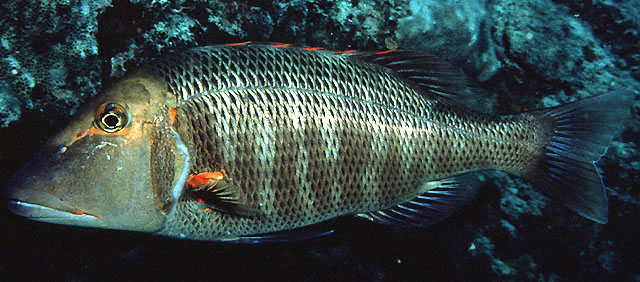| Lethrinidae (Emperors or scavengers), subfamily: Lethrininae |
| 90 cm TL (male/unsexed); max.weight: 9,600.0 g; max. reported age: 22 years |
|
reef-associated; depth range 5 - 30 m, non-migratory |
| Western Pacific: The Ryukyu Islands, eastern Philippines, northern Australia, and New
Caledonia (Ref. 114226). Occurrence records outside distributional range probably refer to Lethrinus olivaceus (Ref. 2295). |
|
Dorsal spines (total): 10-10; Dorsal soft rays (total): 9-9; Anal spines: 3-3; Anal soft rays: 8-8. Snout moderately long. Cheek without scales. Body silvery, tan or yellowish in color, often with a series of 8 or 9 dark bars. Vertical bars may be absent in some individuals. Base of pectoral fin red. Occasionally a red streak is present, originating on the upper operculum, passing beneath the eye and on to the snout. Reddish lips. Fins pale or reddish, sometimes brilliant red on membranes near base of pelvic fin and between spinous rays of dorsal and anal fin. The base of scales often black. |
| Adults inhabit coral reefs during daytime where they feed occasionally in sand and rubble areas between coral heads. At night, they move out over the sandy sea floor and forage actively. Usually occur in small schools. Juveniles live in shallow, inshore waters such as seagrass and mangrove areas, moving into deeper water as they age (Ref. 27260, 28202). Feed mainly on crustaceans, echinoderms, mollusks and fish, with crabs and sea urchins predominating. Much of the information reported for this species was based on misidentifications and referred to L. olivaceous (see Ref. 2295). Marketed fresh or frozen (Ref. 9987). |
|
(Ref. 96402)
|
| reports of ciguatera poisoning |
|
Source and more info: www.fishbase.org. For personal, classroom, and other internal use only. Not for publication.
Page created by Jen, 05.08.02,
php script by kbanasihan 06/09/2010 ,
last modified by
dsantos, 20/08/10

